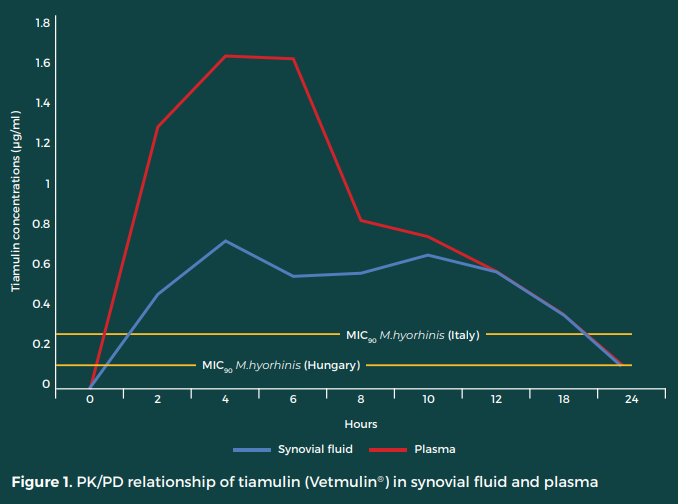- Tweet
- Printer Friendly
PK / PD And Clinical Relationships Of Vetmulin® Injection (Tiamulin Base) Administered To Pigs For The Treatment Of Mycoplasmal Arthritis
Poster presented by Ulrich Klein at ESPHM 2022, Budapest, Hungary
Mycoplasmal arthritis infections can cause lameness, swollen joints and poor growth rates. These symptoms all negatively impact herd performance and therefore profitability. Mycoplasma hyorhinis bacteria causes this disease, but one of the ways it can be controlled is by administration of Vetmulin. The pharmacokinetics (PK) of Vetmulin in the plasma and the synovial fluid were investigated to predict the level of inhibition of mycoplasma.
1U. Klein, 2,3M. Gyuranecz, 4S. Catania, 1L. Claerhout, 1W. Depondt
1 Huvepharma NV Antwerp, Belgium, 2Veterinary Medical Research Institute, Budapest, Hungary, 3 MolliScience Kft., Biatorbagy, Hungary, 4Istituto Zooprofilattico Sperimentale della Venezie, Legnaro, Italy
Background and Objectives
Mycoplasmal arthritis infections in pigs can lead to significant economic losses due to lameness, swollen joints and poor growth. Vetmulin® (tiamulin Huvepharma® NV) Injectable is registered for therapy of Mycoplasmal arthritis infections. The objective of this investigation was to compare the pharmacokinetics (PK) of Vetmulin® Injectable after parenteral administration, to determine the tiamulin concentration in the synovial fluid (SFC) and to relate this to the minimum inhibitory concentration determined by testing of Mycoplasma hyorhinis (Mhr) isolates.
Materials and Methods
Tiamulin plasma concentration and SFC beside other specimen were determined in a pharmacokinetic study with forty healthy pigs (mixed breed, equally male/female, age 3-7 days) medicated once with tiamulin base at 15mg/ kg bw.1 Plasma and synovial fluid concentrations were determined at pre-defined time points (2, 4, 6, 8, 12, 24) over 24 hours. Tiamulin MICs (MIC50, MIC90, MIC ranges) were determined based on testing of Mhr strains isolated during 2019-2021 in Hungary and Italy (20 strains per country).2
Results
The tiamulin SFC was recorded at a consistent plateau concentration between 2-12 hours p.i. (average 0.6 µg/ml). A peak (Cmax) of 0.77µg/ml was determined 4 hours p.i. Plasma tiamulin concentration were higher with a mean ratio plasma:SFC of 1.6:1. Tiamulin MIC90 (0.156µg/ml) value and MIC range (≤0.039-0.156 µg/ml) for Hungarian Mhr strains were slightly lower vs. the MIC90 (0.312µg/ml) value and MIC range (0.078-0.312µg/ ml) for Italian strains. The tiamulin synovial fluid concentration exceeds the MIC90 for approximately 24h recommended dose interval


Conclusion
Vetmulin® Injection PK correlates well with its indication for Mycoplasmal arthritis treatment. After injection of Vetmulin® tiamulin synovial fluid concentrations are above the MIC90 very fast and last for 24 hours. A strong inhibition of both Mycoplasma spp. is expected in the case of tiamulin parenteral administration. The use of PK/PD relationship data is an effective tool in predicting the efficacy of Vetmulin® Injection in the case of Mycoplasmal arthritis/joint infections in pigs.\
References
1 Klein U. et al.(2012). Pharmacokinetics of tiamulin following parenteral application in new-born piglets. Proceedings 22nd IPVS Congress, Jeju, Korea, BP-358, p.715.
2 Földi, D. et al. (2022). Antimicrobial susceptibility profiles of Mycoplasma hyorhinis strains isolated from infected swine across Europe between 2019 and 2021. MolliScience Veterinary Medical Research Institute Budapest, final report.
Source: Huvepharma News Release